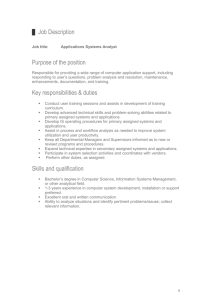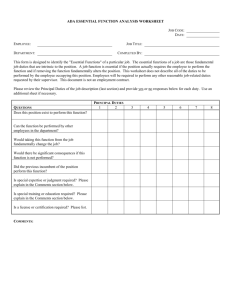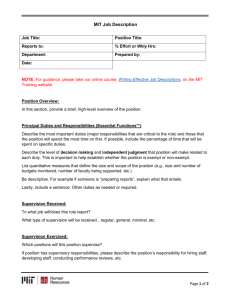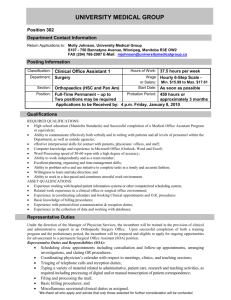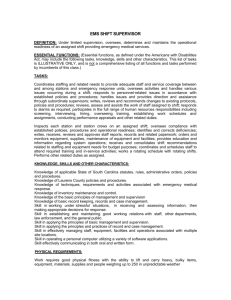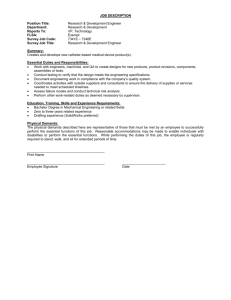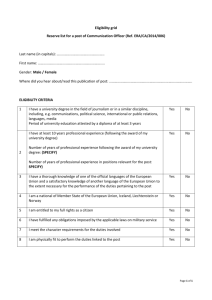7 Steps to Writing an Effective Job Description
advertisement
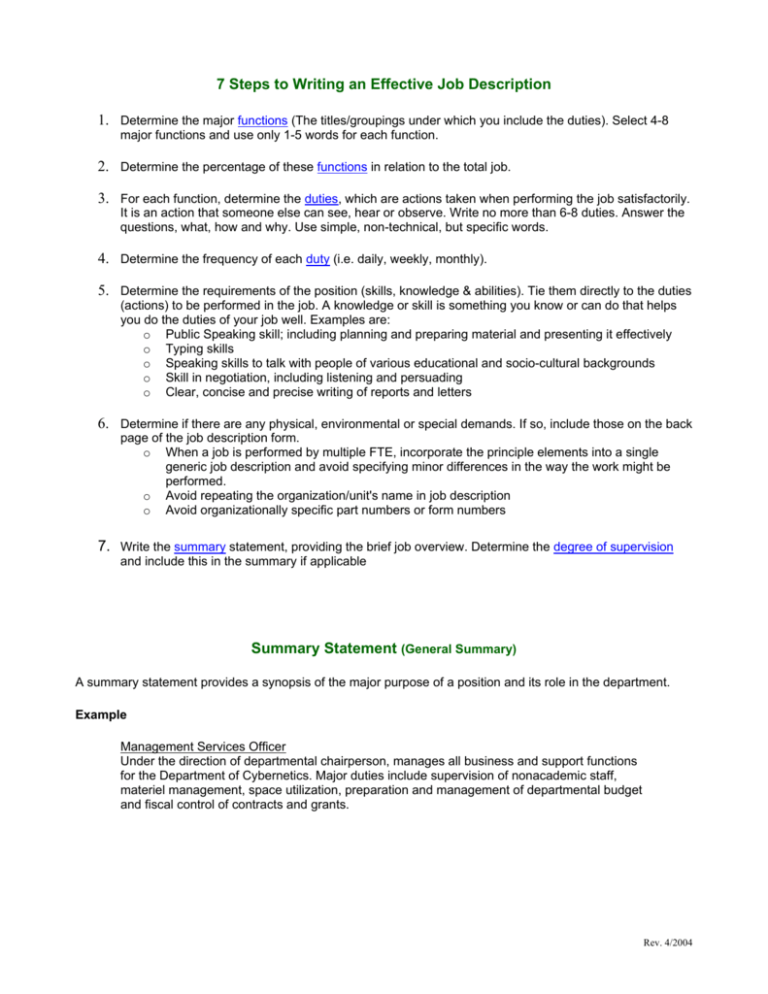
7 Steps to Writing an Effective Job Description 1. Determine the major functions (The titles/groupings under which you include the duties). Select 4-8 major functions and use only 1-5 words for each function. 2. Determine the percentage of these functions in relation to the total job. 3. For each function, determine the duties, which are actions taken when performing the job satisfactorily. It is an action that someone else can see, hear or observe. Write no more than 6-8 duties. Answer the questions, what, how and why. Use simple, non-technical, but specific words. 4. Determine the frequency of each duty (i.e. daily, weekly, monthly). 5. Determine the requirements of the position (skills, knowledge & abilities). Tie them directly to the duties (actions) to be performed in the job. A knowledge or skill is something you know or can do that helps you do the duties of your job well. Examples are: o Public Speaking skill; including planning and preparing material and presenting it effectively o Typing skills o Speaking skills to talk with people of various educational and socio-cultural backgrounds o Skill in negotiation, including listening and persuading o Clear, concise and precise writing of reports and letters 6. Determine if there are any physical, environmental or special demands. If so, include those on the back page of the job description form. o When a job is performed by multiple FTE, incorporate the principle elements into a single generic job description and avoid specifying minor differences in the way the work might be performed. o Avoid repeating the organization/unit's name in job description o Avoid organizationally specific part numbers or form numbers 7. Write the summary statement, providing the brief job overview. Determine the degree of supervision and include this in the summary if applicable Summary Statement (General Summary) A summary statement provides a synopsis of the major purpose of a position and its role in the department. Example Management Services Officer Under the direction of departmental chairperson, manages all business and support functions for the Department of Cybernetics. Major duties include supervision of nonacademic staff, materiel management, space utilization, preparation and management of departmental budget and fiscal control of contracts and grants. Rev. 4/2004 Degree of Supervision This section describes the way in which work is assigned, when it is reviewed, how it is reviewed, and what guidelines, prototypes and protocols are available. Example Management Services Officer Assignments are given in terms of broad organizational goals and objectives. Goal attainment is reviewed with department chairperson on a quarterly basis through presentation of status reports and formal discussions. Department, campus and governmental guidelines relative to budgetary control, contract and grant administration, and personnel management are available for reference, however, interpretation and original problem-solving are required Functions 1. A function is a major subdivision of work performed by one individual. 2. It includes similar duties that make up one area of responsibility 3. Most jobs have 3-6 functions. Examples -- Assistant A. Typing B. Correspondence C. Public contact/Reception D. Conference coordination E. Filing -- Assistant Supervisor A. Organizing work flow B. Training C. Establishing procedures D. Key entry and verifying E. Staffing Management Services Officer A. Budgetary analysis B. Budget administration C. Contract and grant administration D. Supervision of personnel resources E. Materiel management F. Space utilization Rev. 4/2004 Duties 1. A duty is one of the work operations that is a logical, essential step in the performance of a function. 2. It defines the methods, procedures and techniques by which functions are carried out. 3. It should show: o What is done (action). o How it is done (procedures, materials, tools, or equipment). o Why it is done (purpose). Examples --Assistant D. Conference Coordination D1. Schedules speakers for bi-monthly departmental seminars by calling individuals from established listings, ascertaining availability, determining event dates and composing confirming correspondence. --Assistant Supervisor E. Staffing E1. Initiates personnel actions including selecting new employees, conducting performance evaluations, recommending salary increases, providing counseling on disciplinary problems and recommending corrective actions in order to maintain effective staffing and production levels. --Management Services Officer A. Budgetary Analysis A1. Plans and prepares the annual budget by integrating departmental goals and program plans; research, laboratory and administrative requirements; and faculty, student and other statistical data. 4. Begin each duty statement with a present tense action verb, e.g., writes, calibrates, analyzes. TYPE OF SUPERVISION RECEIVED: Close Supervision—indicates that the incumbent is assigned duties according to specific procedures. Work is checked frequently, and in addition there may be formal training. Supervision—indicates that the incumbent performs a variety of routine duties within established policies and procedures or by referral to the supervisor's guidelines. General Supervision—indicates that the incumbent develops procedures for performance of variety of duties; or performs complex duties within established policy guidelines. Direction—indicates that the incumbent establishes procedures for attaining specific goals and objectives in a broad area of work. Only the final results of work done are typically reviewed. Incumbent typically develops procedures within the limits of established policy guidelines. General Direction—indicates that the incumbent receives guidance in terms of broad goals and overall objectives and is responsible for establishing the methods to attain them. Generally the incumbent is in charge of an area of work, and typically formulates policy for this area but does not necessarily have final authority for approving policy. Rev. 4/2004
